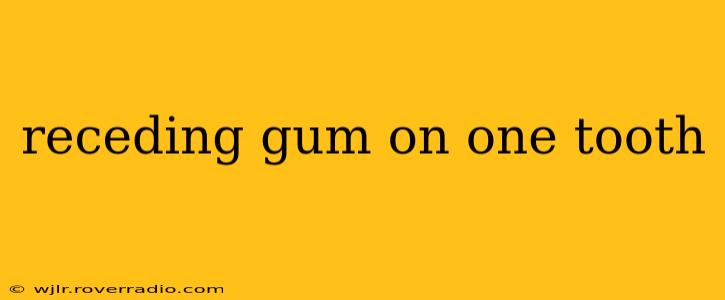Receding gums, also known as gingival recession, is a common dental problem where the gum tissue pulls back from the teeth, exposing more of the tooth's root. While it can affect multiple teeth, sometimes it only impacts a single tooth. This can be alarming, but understanding the causes, available treatments, and preventative measures can ease concerns and promote oral health.
What Causes Receding Gums on One Tooth?
Several factors can contribute to gum recession on just one tooth. It's not always a single cause, but rather a combination of factors. These include:
- Aggressive Brushing: Brushing too hard or using a hard-bristled toothbrush can damage gum tissue over time. This is especially true if you focus your brushing on just one area.
- Gum Disease (Periodontitis): This is a major culprit. Bacteria build up, causing inflammation and infection that damages the supporting tissues holding your teeth in place, leading to recession. While it often affects multiple teeth, it can initially target one area.
- Genetics: Some individuals are genetically predisposed to gum recession, regardless of their brushing habits or oral hygiene.
- Tooth Grinding (Bruxism): Constant grinding or clenching can put excessive pressure on specific teeth, leading to gum recession in that area.
- Misaligned Teeth (Malocclusion): Improperly aligned teeth can cause uneven pressure and stress on the gums, contributing to recession.
- Trauma: An injury to the mouth, such as a blow to the face, can damage the gum tissue around a specific tooth.
- Piercings: Oral piercings, especially those near the gums, can cause irritation and contribute to recession.
How is Receding Gums on One Tooth Treated?
The treatment for receding gums on one tooth depends on the underlying cause and the severity of the recession. Your dentist will conduct a thorough examination to determine the best course of action. Options include:
- Scaling and Root Planing: If gum disease is the cause, this procedure removes plaque and tartar from the tooth roots and smooths the root surfaces to help the gums reattach.
- Gum Grafting: This surgical procedure involves taking gum tissue from another area of the mouth (often the palate) and grafting it onto the affected area to cover the exposed root. Different types of gum grafts exist, chosen based on the specific situation.
- Enamel Matrix Derivative (EMD) Gel: This is a biomaterial gel that can stimulate gum tissue regeneration. It’s often used in conjunction with other treatments.
- Guided Tissue Regeneration (GTR): This surgical technique uses a special membrane to separate the gum tissue from the underlying bone, encouraging the regeneration of lost gum tissue.
- Addressing Bruxism or Malocclusion: If grinding or misaligned teeth are contributing factors, your dentist might recommend a mouthguard or orthodontic treatment.
Does Receding Gums on One Tooth Mean I Need a Root Canal?
Not necessarily. While receding gums can expose the tooth root, making it more susceptible to decay and sensitivity, it doesn't automatically require a root canal. However, if the exposed root becomes infected or significantly decayed, a root canal may become necessary to save the tooth. Regular dental checkups are crucial for early detection and prevention.
Can Receding Gums on One Tooth Be Prevented?
Yes, taking proactive steps can significantly reduce the risk of gum recession.
- Proper Brushing Technique: Brush gently using a soft-bristled toothbrush and a fluoride toothpaste. Avoid aggressive scrubbing.
- Regular Flossing: Flossing removes plaque and food particles from between your teeth, preventing gum disease.
- Regular Dental Checkups: Professional cleanings and examinations are crucial for early detection and treatment of gum disease.
- Mouthguards: If you grind your teeth, wearing a mouthguard at night can protect your teeth and gums.
- Addressing Malocclusion: If you have misaligned teeth, orthodontic treatment can improve your bite and reduce stress on your gums.
What are the Long-Term Effects of Untreated Receding Gums on One Tooth?
Ignoring receding gums can lead to several problems, including:
- Tooth Sensitivity: Exposed tooth roots are more sensitive to hot and cold temperatures.
- Tooth Decay: The exposed root is more susceptible to decay.
- Tooth Loss: Severe gum recession can weaken the support structures of the tooth, leading to loosening and eventual loss.
- Bone Loss: Receding gums often lead to bone loss around the affected tooth, further compromising its stability.
Regular dental check-ups and maintaining good oral hygiene are essential in preventing and managing receding gums. If you notice any signs of receding gums, especially on a single tooth, consult your dentist immediately for a proper diagnosis and treatment plan. Early intervention significantly improves the chances of successful treatment and prevents further complications.
